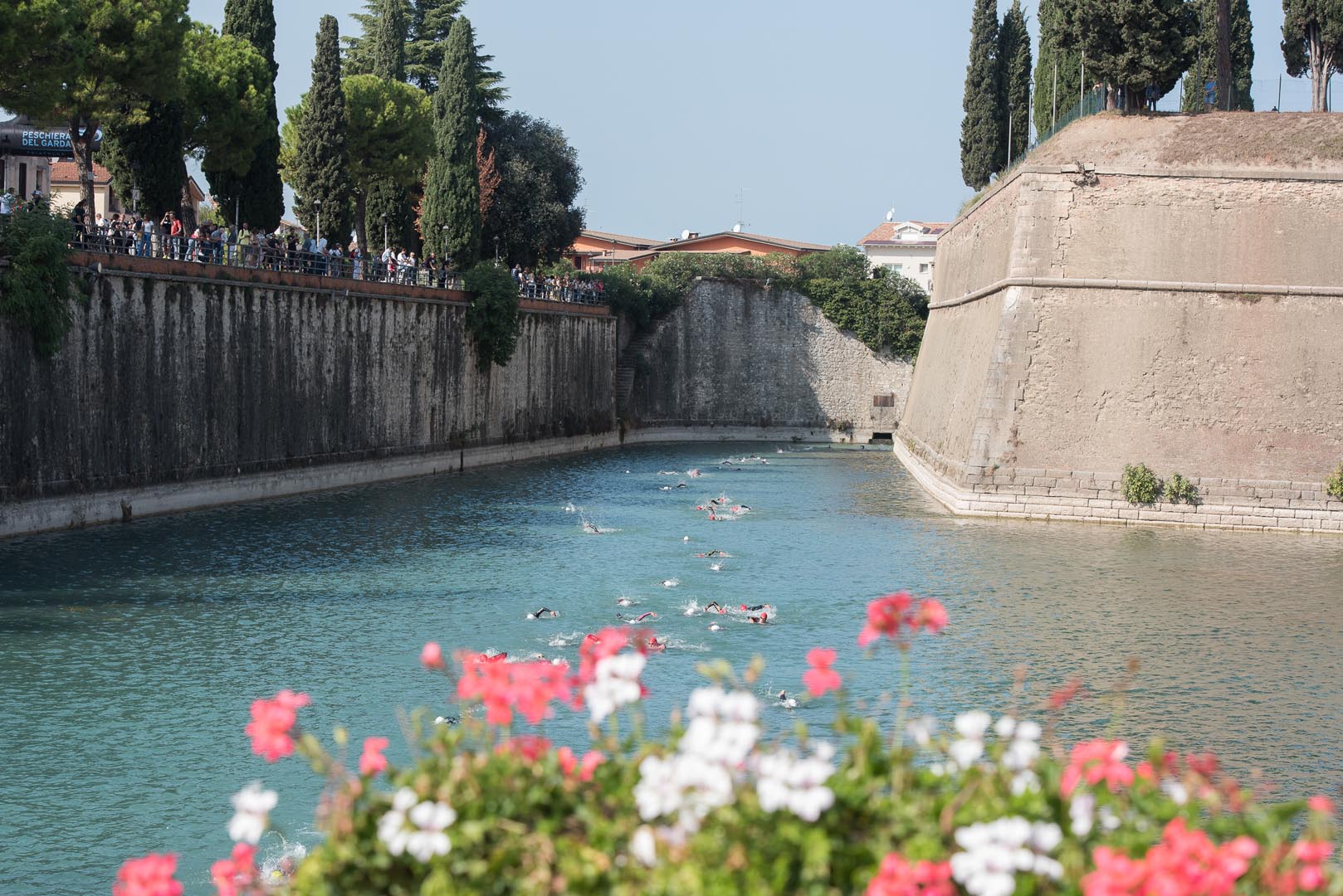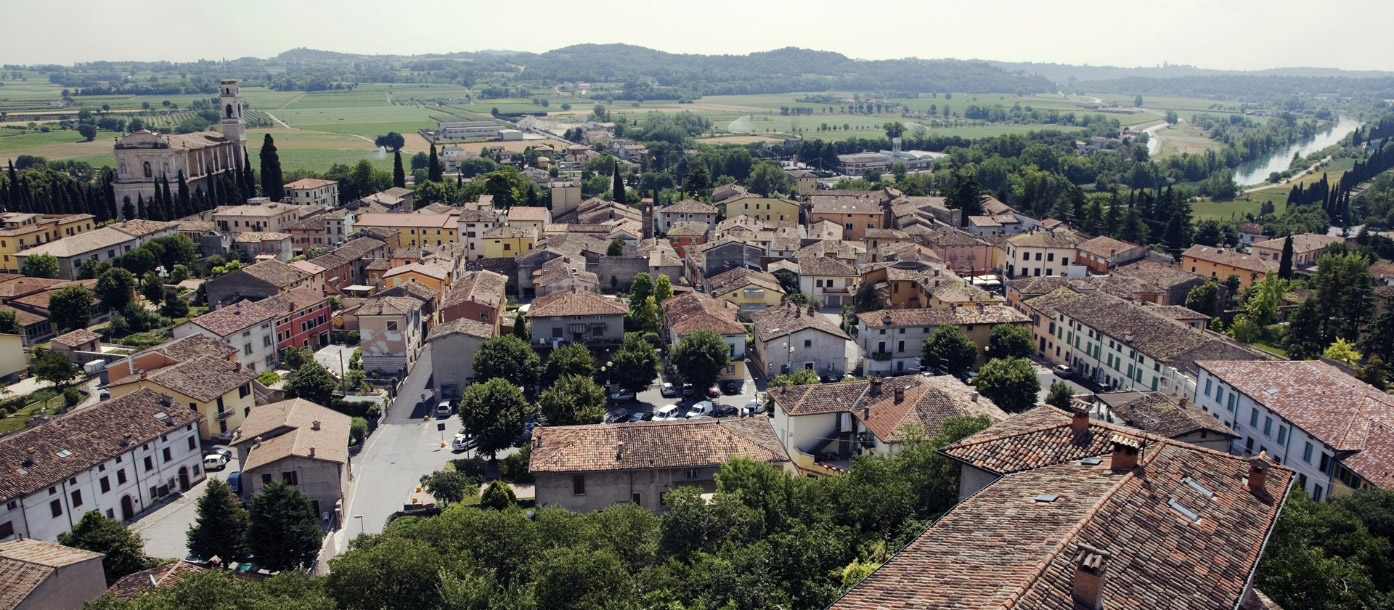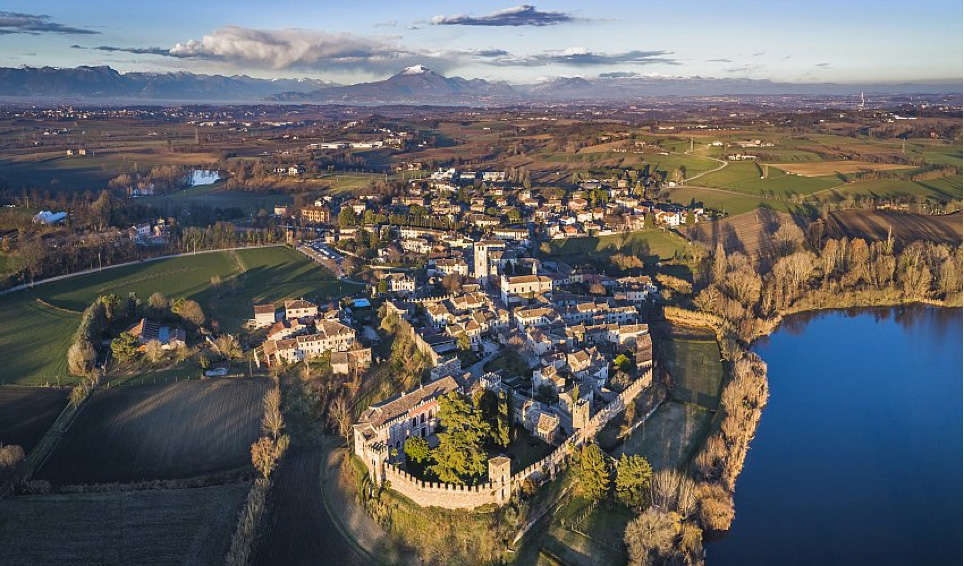PESCHIERA DEL GARDA
Discover Peschiera del Garda and its attractions https://www.comunepeschieradelgarda.com/
MONZAMBANO
Monzambano, with an area of about 30 square kilometers and a population of about 4,800, is located in the heart of the Morenic Hills of Garda. Together with Ponti sul Mincio, it forms the extreme northern tip of the province of Mantua. Castellaro Lagusello has been part of the municipality of Monzambano only since 1806; before that it was a separate entity with a partially different history.
The name of the town itself reveals its morphological characteristics and conformation; although there are several hypotheses, the most credited ones would derive the name from “Mons Ambus” (i.e.: two mountains) or from the Celtic “Mons Zambana” (i.e., mount of the curve, a curve that would probably refer to the depression between the two hills on which the castle is located). In any case, it seems clear that the first characteristic of the area is that it follows the curve of the hills on which the Castle lies. The castle is the oldest part of Monzambano. As anticipated, they follow the course of the ridge of the two hills on which Monzambano lies. Its construction, desired by the Scaligeri as a defensive border structure, dates back to the mid-13th century and is part of a larger plan that also includes the castles of Ponti sul Mincio and Castellaro Lagusello, fortresses that were meant to connect Peschiera del Garda to Borghetto, to make a real border line. The “castrum” has all the characteristics of a Scaliger military structure: shielded towers, defensive moat (in this case, given the position, it could not be filled with water), drawbridge (with two entrances: driveway and pedestrian), two gates plus a defense ring at the entrance, imposing walls with a patrol walkway running along the entire perimeter.
The most interesting part of the visit is definitely the bell tower: from above one can enjoy a beautiful panorama that includes the Castle of Ponti sul Mincio, that of Valeggio (one can well understand how they are on a line), the Church of S. Michele Arcangelo and the Mincio River. Descending from the Castle, one crosses Piazza Vittorio Emanuele III and Via Umberto I, arriving at the Piazzetta delle Arti e Mestieri, walking along Vicolo Balilla, along which one can see elements and materials typical of Venetian Villas, incorporated within the current dwellings. Through the Piazzetta, the current elegant “living room” of the town, one reaches a terraced garden that offers a splendid view of the Mincio River. The river has historically been a fundamental element for the village. Until 1800, when the first bridge was built across it at Monzambano, the river could only be crossed by boat.
CASTELLARO LAGUSELLO
The name of this fortified village includes the two elements that distinguish it: the castle (called at the time “Castlèr”) and the “lagusello,” or heart-shaped lake for which Castellaro is famous. The history of Castellaro is lost in time and is, from the beginning, linked to the presence of the lake, which is in fact of glacial origin, and therefore has always existed. Thanks to its presence, since the Bronze Age man has settled this territory, now dominated by the 12th-century fortress. Traces of an important pile-dwelling site have been found near the pond in the Tacoli Fund, which has been a UNESCO heritage site for a few years as part of the “Prehistoric Pile-Dwelling Sites of the Alpine Arc.” Later, the presence of the Romans was important; among the most important villas was that of the “Batuda,” which returned a mosaic with a rare geometric pattern. The area behind the small lake, on the other hand, is classified as a Nature Reserve of the Mincio Park: this area preserves numerous species of both animals and plants.
The castle within the Borgo, on the other hand, dates back to 1100- 1200, and was defended by crenellated walls and 10 towers (of which 4 remain). In addition to the walls, four towers, parts of the patrol walkway, and two houses from the medieval period in the southern part of the hamlet remain from that ancient castle. The entrance to the village is flanked by a tower that was raised in the 1600s to become a bell tower. From the tower one has, to the north, a panoramic view of the Morenic Hills, of Garda (one can also see the tower of Solferino and S. martino, places of the Risorgimento battles); to the south, on the other hand, there is a beautiful view of the heart-shaped lake and of the whole village, up to the manor house. Walking through the village, still enclosed within the walls, one arrives at Piazza Castello. On the right, Villa Arrighi-Tacoli (the Marquises Tacoli of Modena, to whom the Arrighi were related, are the current owners). On the right, the oratory of San Giuseppe, the family’s private church, dating from 1727. The noble part of the villa remains within the private court, thus overlooking the magnificent English garden that can be glimpsed beyond the gate. The villa, whose present façade, in Venetian style, is the result of a restoration and makeover in the 1800s, stands on the foundations of the ancient keep. In this villa twice in 1796 Napoleon Bonaparte and in 1859, in the aftermath of the famous Battle of Solferino, General Mac-Mahon, commander of the French army, as well as Napoleon III, stayed. At the far end of the square are the only two houses in the village that have remained intact since the Middle Ages; of particular interest is La Casa dell’Ortolano: in ancient times these were two bodies of buildings later joined together; in the side wall is incorporated the doorpost of a door, almost at present ground level, testifying to how much lower the level was in ancient times.





